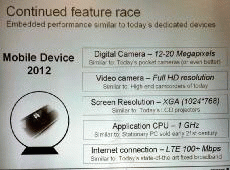November 8, 2008 weblog
Ericsson Predicts Mobile Phones With Full HD, 1 GHz Processor Frequency By 2012

(PhysOrg.com) -- Mobile phones of the future will be equipped with a 12 MP to 20 MP cameras with full HD capability by 2012, according to Jonas Lundstedt, Director of Ericsson's Portfolio Management, Product and Portfolio Management.
New technologies aptly named HSPA Evolution and LTE which means long term evolution will increase the transmission speeds initially to 100Mbps and make possible the progression to full HD quality images. Ericsson plans to actively develop embedded modules, base station facilities and other products in order to bring about the future mobile terminal hand-held device, according to reporter Hiroki Yomogita published on November 6 by Nikkei Electronics.
Currently, HSPA technology has a maximum transmission speed of 7.2Mbps. Ericsson´s system has the lion´s share of commercial networks utilizing HSPA compatible terminals. Today, 805 kinds of HSPA-compatible terminals have been released from approximately 129 manufacturers. According to Hakan Eriksson, Chief Technology Officer at Ericsson, LTE will significantly enhanced the mobile broadband experience for users, who will be able to enjoy more performance-demanding applications like interactive TV, advanced games or professional services. It is expected that 1.8 billion people will have broadband by 2012 and of this amount 2/3 will be mobile broadband subscribers.
Wireless technology will be the predominant way of accessing broadband and Internet connectivity in homes, offices, schools and businesses. Initially, the developing world and other countries will rely primarily on HSPA. LTE is expected to pick up quickly relying on its relationship with the current GSM/WCDMA/HSPA technology family. Another key benefit of LTE is its performance and capacity. Ericsson has already demonstrated peak rates of 160Mbits/s. The future will deliver speeds 300Mbits/s and higher.
The LTE Radio Access Network round trip times will be 10ms or less. Thus, LTE is a prime candidate for the 4G network because it meets all the requirements. Another advantage of LTE is its operator deployment flexibility. It supports flexible carrier bandwidth from 1.4MHz to 20MHz. It also supports both FDD and TDD. The advantage is that an operator may introduce LTE in new bands to where it is easiest for 10 MHz or 20 MHz carriers and eventually switch exclusively to LTE.
According to Mr. Eriksson, the strong market pull for HSPA is creating a burgeoning mobile bandwidth eco-system of device makers, network makers, application developers and enterprises. Since LTE supports hand-over and roaming to existing mobile networks, all devices will have ubiquitous mobile broadband coverage from day one. Ericsson plans to be at the head of the pack for a total transformation of mobile communications. Their vision is a terminal display with XGA resolution and the operating frequency of the application processor will reach 1GHz. It is expected the Japanese market which is moving fast in HSPA will be first to deploy the HSPA Evolution and LTE technology.





















